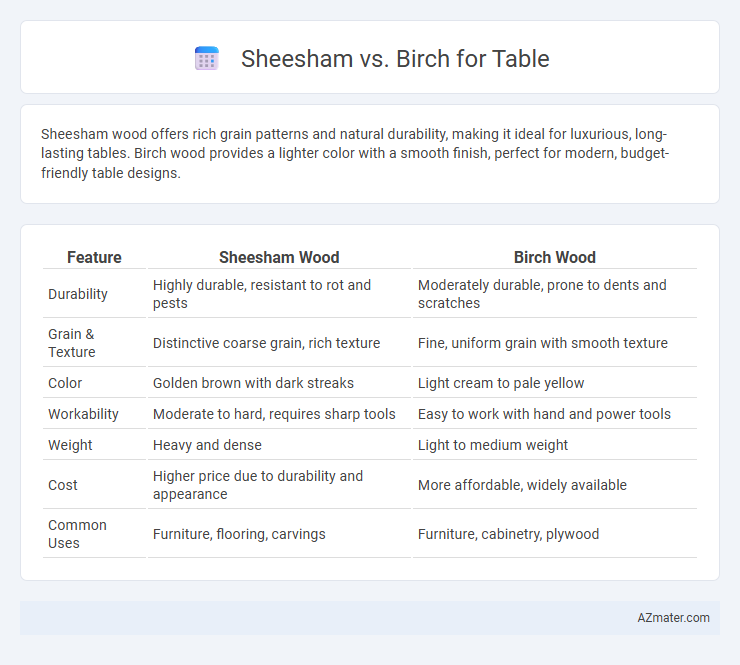Sheesham wood offers rich grain patterns and natural durability, making it ideal for luxurious, long-lasting tables. Birch wood provides a lighter color with a smooth finish, perfect for modern, budget-friendly table designs.
Table of Comparison
| Feature | Sheesham Wood | Birch Wood |
|---|---|---|
| Durability | Highly durable, resistant to rot and pests | Moderately durable, prone to dents and scratches |
| Grain & Texture | Distinctive coarse grain, rich texture | Fine, uniform grain with smooth texture |
| Color | Golden brown with dark streaks | Light cream to pale yellow |
| Workability | Moderate to hard, requires sharp tools | Easy to work with hand and power tools |
| Weight | Heavy and dense | Light to medium weight |
| Cost | Higher price due to durability and appearance | More affordable, widely available |
| Common Uses | Furniture, flooring, carvings | Furniture, cabinetry, plywood |
Introduction: Sheesham vs Birch for Table Making
Sheesham wood, known for its durability and rich grain patterns, offers exceptional strength and natural resistance to decay, making it ideal for long-lasting table construction. Birch features a smooth, uniform texture with a lighter color, providing a modern aesthetic and ease of finishing, though it is generally less dense than Sheesham. Choosing between Sheesham and Birch depends on the desired balance of hardness, appearance, and longevity for table making.
Sheesham Wood: Key Characteristics and Properties
Sheesham wood, also known as Indian rosewood, is prized for its rich color, natural grain patterns, and exceptional durability, making it a popular choice for high-quality tables. Its dense, oily texture offers excellent resistance to wear, decay, and insects, contributing to long-lasting furniture with minimal maintenance. Compared to birch, Sheesham features a higher hardness rating and superior natural resistance, enhancing both aesthetic appeal and functional strength in table construction.
Birch Wood: Key Characteristics and Properties
Birch wood is valued for its fine, even grain and pale color, making it ideal for modern, minimalist table designs that require smooth finishes. Its hardness rating on the Janka scale averages around 1260, offering good durability and resistance to wear, suitable for everyday use in tables. Birch wood also responds well to staining and painting, allowing for versatile aesthetic options in furniture customization.
Durability Comparison: Sheesham vs Birch
Sheesham wood offers superior durability compared to birch due to its dense grain and natural oils that resist decay and insects, making it ideal for long-lasting tables. Birch, while strong and moderately durable, is more susceptible to dents and moisture damage over time, requiring additional treatment for enhanced longevity. Choosing Sheesham ensures a sturdier table with a lifespan that withstands heavy use and environmental stress better than birch.
Appearance and Grain: Visual Differences
Sheesham wood features rich, deep hues with a natural reddish-brown tone and a distinctive grain pattern that is often wavy or curly, giving tables a warm, luxurious appearance. Birch wood has a lighter, creamy color with a fine, even grain that creates a smooth, subtle aesthetic ideal for modern or minimalist table designs. The visual contrast between Sheesham's bold, textured grain and Birch's uniform, pale surface makes Sheesham tables stand out with character while Birch tables offer a clean, understated elegance.
Workability and Craftsmanship Considerations
Sheesham wood is prized for its natural durability and rich grain, making it highly workable for intricate carving and detailed craftsmanship in tables, while its hardness provides excellent resistance to wear. Birch offers a smoother texture and consistent grain, facilitating easier machining and finishing, ideal for precision joinery and uniform surface treatments. Both woods respond well to hand and machine tools, but Sheesham's oily nature demands more careful sanding and finishing to achieve a polished look, contrasting with Birch's more straightforward finishing process.
Cost Analysis: Sheesham vs Birch Tables
Sheesham tables typically cost more than birch tables due to the hardwood's durability and rich grain pattern that adds aesthetic value and longevity, making it a preferred choice for premium furniture. Birch, being a softer and more readily available wood, offers a more budget-friendly option while maintaining reasonable strength and a lighter color that suits modern interiors. When considering long-term investment, Sheesham's resistance to wear and natural oils that prevent termite attacks justify its higher initial price compared to the cost-effective, yet less robust, birch tables.
Sustainability and Environmental Impact
Sheesham wood is a sustainable choice due to its fast growth and natural resistance to pests, reducing the need for chemical treatments that harm the environment. Birch, commonly sourced from temperate forests, offers a renewable option when harvested under responsible forestry practices, minimizing deforestation impact. Both woods provide durable furniture material with a lower carbon footprint compared to synthetic alternatives, making them eco-friendly selections for tables.
Best Use Cases: Which to Choose for Your Table
Sheesham wood is ideal for rustic or traditional tables, offering rich grain patterns, natural oils for durability, and excellent resistance to pests and decay. Birch, known for its smooth grain and lighter color, suits modern or Scandinavian-style tables, providing a sturdy yet sleek finish that takes paint or stain well. Choose Sheesham for robust, long-lasting furniture with character, and Birch for affordable, versatile, and easily customizable tabletops.
Conclusion: Final Verdict on Sheesham vs Birch Tables
Sheesham tables offer exceptional durability and unique grain patterns, making them ideal for long-lasting, eye-catching furniture pieces. Birch tables provide a lighter, more uniform appearance with smooth finishes and are generally more affordable, suited for modern or minimalist settings. Choosing between Sheesham and Birch depends on preferences for wood aesthetics, budget, and desired table longevity.

Infographic: Sheesham vs Birch for Table
 azmater.com
azmater.com